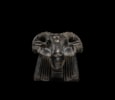Head of Khnum
Head of Khnum
Egypt
1296-656 B.C, New Kingdom to Third Intermediate Period
Steatite
H: 7.9 x W: 6.6 cm
Sold
Head of the god Khnum carved out of black steatite. As is typical of depictions of Khnum, the god is shown with a ram’s head, with a wig and usekh collar. The two large horns curve inwards and forwards towards the face, in the style of later representations of Khnum (earlier images depict the god with corkscrew horns extending horizontally from his head, to distinguish him from the curved-horned god Amun). The head is pierced vertically through the centre, allowing it to be mounted as a finial.
Khnum was one of the most ancient gods of Egypt, who was worshipped from as early as the Predynastic Period and into the early centuries C.E. Originally a water god, Khnum was the patron god of the First Cataract (area of rapids) of the Nile, and protector of its source. The Egyptians believed that the waters of the Nile proceeded from the god Nun from a hole in the earth at Elephantine, where one of Khnum’s most important temples was based. The inundation waters bearing fertile mud were also thought to come from this source; Khnum often features in creation myths using a potter’s wheel and primordial mud to create man and his ‘ba’ (spirit), to create children within their mother’s womb, and to assist in birth alongside the frog goddess Heqet. In some myths, Khnum is said to have created the ‘First Egg’ from which the sun was born. He also had an important cult in Esna, south of Thebes. Khnum was depicted variously as a ram, or a man with a ram’s head or horns, and very occasionally with a hawk’s head, in reference to his role as the ‘ba’ of the sun-god Re (who is depicted with a ram’s head during his nocturnal journey through the underworld).
A. Daninos, Collection d’Antiquités Égyptiennes de Tigrane Pacha d’Abro (Paris, 1911), p. 19, no. 487, plate XLII.
Previously in the Private Collection of Tigrane Pasha (c. 1847-1904), Cairo and Evian-les-Bains, France, from at least 1904.
Private Collection of Dina (1928-2021) and Raphael (1924-1999) Recanati, New York, acquired by c. 1965.
Thence by bequest.
ALR: S00231177,With IADAA certificate, this item has been checked against the Interpol Database.
Tigrane Pasha was an Egyptian-Armenian politician and the ninth Foreign Minister of Egypt, who served under three successive prime ministers from 1891 to 1904. He was nephew to Nubar Pasha (1825-1899), the first Prime Minister of Egypt, who appointed Tigrane to the railway administration in 1865. In 1878, Tigrane served as secretary general of the Council of Ministers during his uncle’s first term as prime minister. Views on Tigrane’s policies were divided. Richard Harding Davis described Tigrane as ‘more of a diplomat than a statesman’ and ‘a man who has a better knowledge of many different governments than half of the English cabinet have of their own, and who wishes the best for his Khedive and his country’. However, not everyone viewed him so favourably. When the Khedive, Abbas II (a good friend of Tigrane), nominated Tigrane as the candidate to replace Mustafa Fahmi as Prime Minister, Sir Evelyn Baring, the first Earl of Cromer, took steps to block this move. Baring, who served as the British Controller-General in Egypt 1878-1879 and Consul-General from 1883-1907, claimed Tigrane was out of touch with local opinion and advocated for the nomination of a Muslim premier. However, Baring’s opposition may well have lay in the fact that Tigrane strongly believed Egypt should be governed without British involvement. Known for being a rake, Tigrane faced Italian statesman Marco Minghetti in a duel to the death in Alexandria in 1877. One newspaper reported the reason for the dispute simply as ‘the familiar fact that there is a lady in the case’. After three shots were exchanged, Tigrane’s pistol barrel burst and damaged his hand, which satisfied Minghetti’s seconds (though Tigrane’s seconds were keen to continue).
Tigrane’s collection of Egyptian antiquities was catalogued by French archaeologist Albert Daninos-Pacha in 1904, and several pieces from his collection are now in the Metropolitan Museum, New York.
Dina Recanati (née Diane Hetton) was born in Cairo in 1928. As an artist, she worked across a range of media including installations, silkscreen prints, reliefs, and tapestries. Much of her work was inspired by her childhood in Egypt, as well as the art she collected. She married Greek-born Israeli-American businessman and banker, Raphael Recanati in 1946, and they moved to London shortly after. Here Dina devoted herself seriously to the study of art history. In 1948 the couple moved to New York, where Dina began to explore and collect the works of American abstract artists, including Robert Motherwell, Kenneth Noland, and Louise Nevelson. She enrolled in the Arts Students League in 1959, where she studied under Jose de Creft and John Hovannes. Although both her art and her collections span a diverse range of movements and media, the central theme is that of the interior life of the artist. For Dina, ‘Art is where we find shelter when we no longer comprehend the world around us.’
Raphael Recanati served as founder and chairman of the Overseas Shipholding Group and chairman of the Israel Discount Bank from 1982 to 1986. In his youth, he served in the Palmach, the underground army of the Yishuv during the period of the British Mandate for Palestine. Recanati also served as an emissary in Egypt during the Aliyah Bet (clandestine immigration). He was known for his philanthropy and served on the boards of trustees of the Weizmann Institute of Science, the American Friends of Ben-Gurion University of the Negev, and the American Friends of Tel Aviv University, where he endowed the Recanati School of Business. Together, the Recanatis supported the Heart Institute at Beth Israel Medical Center, established the Recanati Cardiology Research Fund and set up an endowed professorship in Immunology at the Harvard University Medical School.










 Enquire
Enquire




